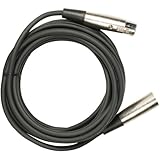
Everyone develops personal preferences over time for one reason or another. I have a personal preference for the XLR ends with the really fine threaded plastic cap on the outside (first to slide down the cable) with a 4 legged gripper underneath that slides next down the cable and pinches down as you tighten the plastic outer cap into the metal housing with the solder contacts causing the gripper to strain relief most cable diameters. Unfortunately that design isn't used here, but I chose to award the 5 star rating for value because you get 15' of good quality shielded cable with 2 XLR ends (M and F) for well under $1/ft.
As for pinout it's straightforward, pin 1 is tied to the metal grip and shield and connects between both ends, while pins 2 and 3 are run isolated between both ends. The end design chosen uses the single set screw connector (the tiny one that gets lost so easy if you need to take it apart) and the rubber bumper design on the back which I haven't had the best of luck making quick changes in the field with, however for interconnecting equipment on a temporary basis these cables are an important starting point of any audio engineer's kit because they will be used not if but WHEN the need arises.
Another favorite of mine is the 6 pack of 3 foot male to female cables which do use my favorite XLR ends mentioned above, which amazon will rush you: GLS Audio 3ft Patch Cable Cords - XLR Male To XLR Female Black Cables - 3' Balanced Snake Cord - 6 PACK - these are very easy to open an end, change phase, lift ground, or input someone's oddball source signal. Having 6 on hand means you won't quibble over cable costs before the show starts and that channel will be in the final mix.
Back to pyle's product here, I basically took away 1 star for not using the easy to open and re-wire XLRs but gave them a star for value in the product since it's 15 feet long and will reach between my mixer and most anything else inside the booth for under a buck a foot. It's also great when someone yells "it's too short I need a cable stretcher at the podium!" and quickly adds 15 feet of noise free movement to a stage snake that either wasn't planned for or got moved/quit working. For the price they have saved many installations from being torn up or rewired which means no surprises opening the next showing.
I finally equipped my cable kit with the usual XLR to RCA, 1/4 TRS, hi-z transformers, and the above mentioned 6 pack of 3 foot cables to quickly gain access to the XLR terminals if need be, plus 2 of these 15 foot cables mainly to solve distance problems, and a roll of gaffer's tape for good measure to prevent tripping hazards. I used to have 2ea 50 foot XLR cables but no sooner than the box was opened one became a permanent addition to the stage snake so now I have one left for my kit. With all that I had to build an emergency XLR to 2.5mm TS all metal shielded connector for a mike input on short notice so a soldering kit with misc plugs got added to my cable bin. Even though all this was under $100 it has saved the day more than once and made the show go on, so a bit of "what if" thinking and judicial purchases can make you look like the miracle mixer in the black painted room and justify your existance when the owner's daugher's toy musicbox becomes a channel in the house mix thanks to some quick cable magic.
My last cable advice is never deconstruct something you custom made. It will no doubt be needed again, and since you made it you'll know why, how, and where it was used before, thus you save time not recreating a past fix rather pulling it from your magic box of tricks and solving the problem. People think you can hook anything up where others tried and failed furthering your staff position. My only exception goes to cables that violate every standard and didn't serve to fix the problem like that phase reversed ground lifted XLR 4 pin stereo Y splitter to dual TRS female cable I made for the harmonica duet where the performers had nose rings and lip bars pierced and kept getting static with their mics when they held the harmonica up to their jewelry. I chalked that up to being part of the intended musical signal, wondering just how much it hurt to play with all the piercings scraping along the harmonica when I setup my monitor speakers to listen to just that (stereo) channel in rehersal at the console.Get more detail about XLR male to XLR female Microphone Cable - 15 feet.
No comments:
Post a Comment